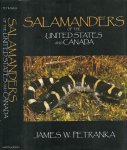SludgeMunkey
New member
Salamanders of the United States and Canada
James W. Petranka
(Smithsonian Institution Press, 1998)
587 pages
This is the result of the first complete caudate survey in North America published since 1943. It covers the 127 species found north of the Rio Grande River. While the book itself states that there are some arguments about taxonomic status of quite a few subspecies, Petranka tends to avoid these issues and stick to what is generally agreed upon. He skips a lot of the ultra-detailed biology in favor of getting the basics down to help provide positive identification.
Each animal identified in the book has information on identification, systemics, distribution, habitat, reproduction,and ecology. A black and white photograph is also in place for each animal. A full color plates section is also included for many of the more common and beautiful species. Both the scientific nomenclature and the most commonly used common names are also provided. Also included is information for engineers describing conservation biology.
Interesting Highlights:
Introduction and Salamander Identification- From coastal grooves to nasolabial folds, this short section covers the basics of caudate identification. It very plainly demonstrates common practice in species identification.
Unisexual Ambystomatidae: This section covers in detail the various tiger salamander hybrids that exist in the wild. Quite a learning experience!
Full Color Plates: I like to call this the "drool" pages. 172 full color high resolution photographs of the most commonly found caudates in the United States.
Bibliography: It is like a species specific clearing house of every major caudate scientific paper pertaining to the subject matter. In itself, it is hours of reading and research.
Easy to read and coupled with a full bibliography of references, this book is a must have for anyone interested in caudates. It is indispensable for the enthusiast and professional field herpetologist alike! I would refer to this as a field guide, however, the sheer size and weight of this perfectly written book makes it a bit unweildy for pack material. New copies are a bit pricey, ranging up to around 70 USD, however used copies can be purchased for significantly less.
My only real complaint is that there is no field edition available. Personally, I would pay top dollar for a smaller, lighter weight version with water resistant pages I could drag around to every wet spot in the country.
James W. Petranka
(Smithsonian Institution Press, 1998)
587 pages
This is the result of the first complete caudate survey in North America published since 1943. It covers the 127 species found north of the Rio Grande River. While the book itself states that there are some arguments about taxonomic status of quite a few subspecies, Petranka tends to avoid these issues and stick to what is generally agreed upon. He skips a lot of the ultra-detailed biology in favor of getting the basics down to help provide positive identification.
Each animal identified in the book has information on identification, systemics, distribution, habitat, reproduction,and ecology. A black and white photograph is also in place for each animal. A full color plates section is also included for many of the more common and beautiful species. Both the scientific nomenclature and the most commonly used common names are also provided. Also included is information for engineers describing conservation biology.
Interesting Highlights:
Introduction and Salamander Identification- From coastal grooves to nasolabial folds, this short section covers the basics of caudate identification. It very plainly demonstrates common practice in species identification.
Unisexual Ambystomatidae: This section covers in detail the various tiger salamander hybrids that exist in the wild. Quite a learning experience!
Full Color Plates: I like to call this the "drool" pages. 172 full color high resolution photographs of the most commonly found caudates in the United States.
Bibliography: It is like a species specific clearing house of every major caudate scientific paper pertaining to the subject matter. In itself, it is hours of reading and research.
Easy to read and coupled with a full bibliography of references, this book is a must have for anyone interested in caudates. It is indispensable for the enthusiast and professional field herpetologist alike! I would refer to this as a field guide, however, the sheer size and weight of this perfectly written book makes it a bit unweildy for pack material. New copies are a bit pricey, ranging up to around 70 USD, however used copies can be purchased for significantly less.
My only real complaint is that there is no field edition available. Personally, I would pay top dollar for a smaller, lighter weight version with water resistant pages I could drag around to every wet spot in the country.

